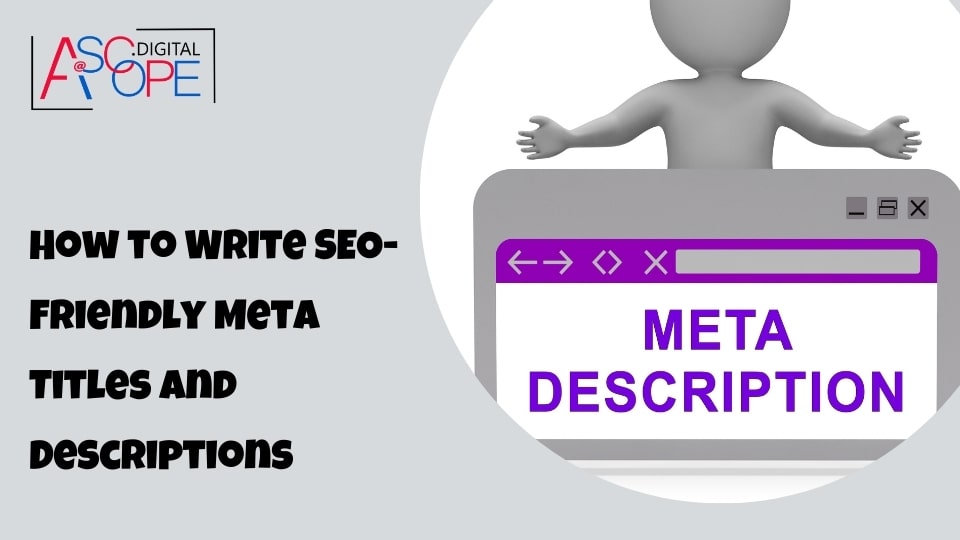Search Engine Optimization (SEO) is a vital aspect of digital marketing that helps increase the visibility of your website on search engine results pages (SERPs). One of the most important elements of on-page SEO is crafting effective meta titles and descriptions. These elements not only help search engines understand the content of your page but also entice users to click on your link. In this comprehensive guide, we will explore how to write SEO-friendly meta titles and descriptions that can improve your website’s traffic and sales.
Understanding Meta Titles and Descriptions
Meta titles and descriptions are HTML elements that provide information about the content of a web page. The meta title appears at the top of the browser tab and is also used as the clickable headline on SERPs. The meta description, on the other hand, is a brief summary that appears below the meta title on SERPs. Both elements play a crucial role in on-page SEO and user experience.
The Importance of Meta Titles and Descriptions
Meta titles and descriptions play a crucial role in the overall success of your website’s SEO strategy. Here’s an in-depth look at why these elements are essential:
First Impression
Meta titles and descriptions are the first elements users encounter on Search Engine Results Pages (SERPs). They serve as the digital handshake, offering a brief glimpse into the content of your webpage. A compelling meta title and description can significantly increase the likelihood of users clicking on your link over others. It’s akin to a book cover; an enticing title and blurb can draw readers in, encouraging them to delve deeper into the content. Therefore, crafting engaging and informative meta titles and descriptions is vital for capturing user interest at first glance.
SEO Ranking
Search engines, such as Google, use meta titles and descriptions to understand the relevance of a page to a user’s query. These elements provide context and clues about the content of the page, aiding search engines in indexing and ranking your pages appropriately. A well-optimized meta title and description, infused with relevant keywords, can improve your page’s visibility on SERPs. This enhanced visibility translates to higher rankings, making it easier for potential visitors to find your website when searching for related topics.
Click-Through Rate (CTR)
A well-crafted meta title and description can significantly improve your Click-Through Rate (CTR). CTR is a critical metric that measures the number of clicks your link receives divided by the number of times it is shown (impressions). Search engines consider CTR a significant ranking factor, as it indicates the relevance and appeal of your content to users. By optimizing your meta titles and descriptions to be clear, compelling, and aligned with user intent, you can increase your CTR, leading to better rankings and more organic traffic.
User Experience
Meta titles and descriptions provide users with a snapshot of what to expect on your page, enhancing the overall user experience. When users see a meta title and description that accurately reflects the content of your page, they are more likely to find the information they are seeking. This alignment between expectation and content reduces bounce rates, as users are less likely to leave your page immediately after arriving. A positive user experience is crucial for building trust and credibility, encouraging users to explore more of your website and engage with your content.
Additional Considerations
- Branding: Consistent and well-thought-out meta titles and descriptions can reinforce your brand’s voice and message. Including your brand name in meta titles can help increase brand recognition and trust.
- Content Differentiation: With countless web pages competing for attention, meta titles and descriptions offer an opportunity to differentiate your content. Highlighting unique selling points or value propositions in these elements can set your page apart from competitors.
- Structured Data: Incorporating structured data (schema markup) can enhance your meta descriptions with rich snippets, providing additional information such as ratings, reviews, and prices. This can further entice users to click on your link.
How to Write SEO-Friendly Meta Titles

Creating SEO-friendly meta titles involves a combination of keyword optimization, clarity, and appeal. Here are some tips to help you craft effective meta titles:
1. Include Target Keywords
Incorporating your target keywords in the meta title is crucial for SEO. Search engines use these keywords to determine the relevance of your page. However, ensure that the keywords fit naturally and do not appear forced.
Example: If your target keyword is “best coffee makers,” a good meta title could be “Best Coffee Makers 2024 – Top Picks and Reviews.”
2. Keep It Under 60 Characters
Search engines typically display the first 50-60 characters of a meta title. Keeping your meta title within this limit ensures that it is fully visible on SERPs.
3. Make It Compelling
Your meta title should be attractive and encourage users to click on your link. Use action words and create a sense of urgency or curiosity.
Example: “Discover the Best Coffee Makers of 2024 – Expert Reviews Inside!”
4. Include Your Brand Name
If you have a well-known brand, including it in your meta title can help build trust and recognition. Place your brand name at the end of the meta title to keep the focus on the primary keywords.
Example: “Best Coffee Makers 2024 – Top Picks and Reviews | CoffeeWorld”
How to Write SEO-Friendly Meta Descriptions
Meta descriptions, though not directly influencing search engine rankings, play a crucial role in improving your click-through rate (CTR) and enhancing the overall user experience. Crafting compelling meta descriptions can attract more users to your site and provide a better understanding of your content. Here are some detailed tips for writing effective meta descriptions:
1. Include Target Keywords
Incorporating your target keywords in the meta description is essential for helping search engines comprehend the content of your page. When users search for these keywords, they will appear in bold in the search engine results pages (SERPs), making your listing more noticeable.
Example: “Looking for the best coffee makers of 2024? Check out our expert reviews and find the perfect coffee maker for your home or office.”
2. Keep It Under 160 Characters
Search engines generally display only the first 150-160 characters of a meta description. By keeping your description within this character limit, you ensure that it remains fully visible on SERPs, thus conveying your message effectively.
3. Make It Descriptive and Persuasive
Your meta description should offer a clear summary of the page content and entice users to click. Highlight the unique benefits and features of your content to stand out.
Example: “Discover the top coffee makers of 2024 with our expert reviews and buyer’s guide. Find the perfect coffee maker for your needs and budget. Read more inside!”
4. Use a Call-to-Action (CTA)
Including a call-to-action in your meta description encourages users to take action. Effective CTAs like “learn more,” “discover,” “read our guide,” or “find out” can significantly improve your CTR.
Example: “Need a new coffee maker? Discover our top picks and read expert reviews to find the best option for you. Click to learn more!”
Best Practices for Meta Titles and Descriptions
To optimize your meta titles and descriptions for maximum effectiveness, follow these best practices:
1. Avoid Duplicate Meta Titles and Descriptions
Each page on your website should have a unique meta title and description. Duplicate meta information can confuse search engines and negatively impact your SEO, leading to lower visibility and rankings.
2. Match Meta Information with Page Content
Ensure that your meta titles and descriptions accurately reflect the content of the page. Misleading meta information can result in high bounce rates and a poor user experience, as users will leave your site if they do not find what they expect.
3. Regularly Update Meta Information
Search trends and user behaviors evolve over time, making it important to regularly review and update your meta titles and descriptions to keep them relevant and optimized. Regular updates ensure that your content remains aligned with current search intents.
4. Monitor and Analyze Performance
Use tools like Google Search Console and analytics platforms to monitor the performance of your meta titles and descriptions. Analyzing metrics such as CTR, impressions, and rankings can help you identify areas for improvement and make data-driven decisions.
Common Mistakes to Avoid
When crafting meta titles and descriptions, be mindful of these common pitfalls:
1. Keyword Stuffing
Overloading your meta titles and descriptions with keywords can make them appear spammy and unappealing. Focus on creating natural, readable content that incorporates keywords seamlessly.
2. Ignoring the User
While optimizing for search engines is important, never forget the user. Your meta titles and descriptions should be engaging, relevant, and tailored to address the user’s query effectively.
3. Using Generic Phrases
Avoid generic phrases like “Home” or “About Us” as they provide little value to users or search engines. Be specific and descriptive about the page content to attract more targeted traffic.
4. Not Including CTAs
A meta description without a CTA may not compel users to click on your link. Always include a clear and compelling CTA to drive user action and increase engagement.
Examples of Effective Meta Titles and Descriptions

To help you understand how to apply these tips, here are some examples of effective meta titles and descriptions:
Example 1:
- Meta Title: “Best Running Shoes 2024 – Top Picks and Reviews”
- Meta Description: “Find the best running shoes of 2024 with our expert reviews and buyer’s guide. Discover the top brands and models for every type of runner. Read more inside!”
Example 2:
- Meta Title: “How to Start a Blog – Step-by-Step Guide for Beginners”
- Meta Description: “Learn how to start a successful blog with our step-by-step guide. From choosing a niche to monetizing your blog, we cover it all. Click to get started!”
Example 3:
- Meta Title: “Healthy Dinner Recipes – Quick and Easy Meals”
- Meta Description: “Looking for healthy dinner ideas? Check out our collection of quick and easy recipes that are delicious and nutritious. Find your new favorite meal today!”
Conclusion
Writing SEO-friendly meta titles and descriptions is a critical component of on-page SEO. By following the tips and best practices outlined in this guide, you can create meta information that improves your website’s visibility, CTR, and user experience. Remember, a well-crafted meta title and description can be the deciding factor in whether a user clicks on your link or chooses a competitor’s.
Thus, improving traffic and sales for your website. Read more on the other reasons why your website isn’t getting traffic. Consistently monitoring and updating your meta information based on performance data will help you stay ahead of the competition and achieve your SEO goals. By implementing these strategies, you can enhance the overall effectiveness of your SEO efforts and drive more organic traffic to your website. Keep experimenting, analyzing, and optimizing to ensure your meta titles and descriptions remain relevant and impactful.


